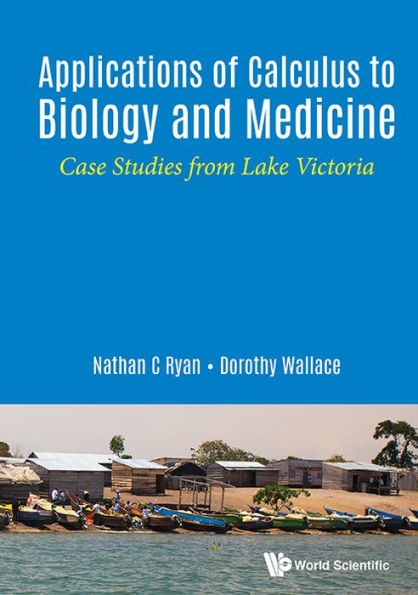Table of Contents
Preface xi
Mathematics in the biological sciences xi
How we have used this book xii
Students as researchers xiii
Some details about the book xiv
Conclusion xv
Part 1 Background 1
Chapter 1 Lake Victoria 3
1.1 Humans around Lake Victoria 3
1.2 Challenges facing Lake Victoria 4
1.3 Our small contribution 7
Bibliography 7
Chapter 2 What is Calculus? 9
2.1 Biological context 9
2.2 Rates of change 9
2.3 The derivative at a point 11
2.4 The derivative as a function 12
2.5 Antiderivatives 13
2.6 Fitting a tumor growth model to data 15
2.7 Conclusion 16
Bibliography 17
Part 2 Population modeling 19
Chapter 3 Introduction to Population Modeling 21
3.1 Biological context 22
3.2 The model 22
3.3 Implications 27
3.4 Analysis of the model 28
3.5 Differential equation terminology 29
3.6 Dimensional analysis and models 31
3.7 Problems 31
Bibliography 32
Chapter 4 Logistic Growth 35
4.1 Biological context 36
4.2 The model 37
4.3 Analysis of the model 38
4.4 Model versus real world data 45
4.5 Implications of the model 46
4.6 Problems 46
Bibliography 50
Chapter 5 Harvesting a Population with Logistic Growth 51
5.1 Biological context 51
5.2 The model 53
5.3 Analysis of the model 55
5.4 Implications of the model 56
5.5 Problems 57
Bibliography 58
Chapter 6 Euler's Method 59
6.1 The method 59
6.2 Problems 61
Bibliography 62
Chapter 7 Modeling Interlude: The Modeling Process 63
7.1 Added value 63
7.2 A list of questions for a model-designer to consider 64
7.3 Approach in this book 65
7.4 The biological models in this book 66
Chapter 8 Research Interlude: Reading a Research Paper 69
8.1 Finding existing models of something 69
8.2 Close reading 71
8.3 Finding parameter estimates for your model 72
Chapter 9 Brief Introduction to Sage 75
9.1 Try it out! 75
9.2 Getting Sage 76
9.3 Solving and plotting differential equations in Sage 77
9.4 Basic Sage programing 77
Bibliography 79
Chapter 10 Projects for Population Modeling 81
Bibliography 84
Part 3 Drug modeling 85
Chapter 11 Introduction to Pharmacokinetics 87
11.1 Biological context 87
11.2 The model 89
11.3 Half-life 91
11.4 Implications of the model 92
11.5 One compartment IV administration: Pharmacokinetic details 93
11.6 Problems 95
Bibliography 96
Chapter 12 Two Models for Lead in the Body 97
12.1 Medical context 97
12.2 The first model 98
12.3 The second model 103
12.4 Implications 104
12.5 Problems 104
Bibliography 105
Chapter 13 Methods of Drug Administration 107
13.1 Biological context 108
13.2 Multi-compartment pharmacokinetic models 108
13.3 Method of residuals 111
13.4 The model for halofantrine 112
13.5 Problems 115
Bibliography 116
Chapter 14 Euler's Method for Systems of Differential Equations 117
14.1 Vector notation 118
14.2 Existence and uniqueness 121
14.3 Problems 121
Bibliography 122
Chapter 15 Modeling Interlude: Sensitivity Analysis 123
15.1 Notation 123
15.2 The basic question and a basic solution 124
15.3 An example 125
15.4 Problems 127
Chapter 16 Research Interlude: Writing a Research Paper 129
16.1 Components of a scientific paper 129
16.2 Putting pen to paper (or fingers to keyboard) 131
Bibliography 132
Chapter 17 Projects for Pharmacokinetic Modeling 133
17.1 Projects 133
Bibliography 135
Part 4 Predator prey modeling 137
Chapter 18 Undamped Lotka-Volterra Equations 139
18.1 Biological context 140
18.2 The model 143
18.3 Analysis of the model 145
18.4 Implications of the model 150
18.5 Plotting phase portraits in Sago 153
18.6 Problems 156
Bibliography 156
Chapter 19 Damped Lotka,-Volt err a Equations 159
19.1 Biological context 159
19.2 The model 160
19.3 Analysis of the model 161
19.4 Problems 165
Chapter 20 Predator Satiation 167
20.1 Biological context 167
20.2 The model 170
20.3 Problems 173
Chapter 21 Isoclines 175
21.1 Biological context 175
21.2 Problems 181
Chapter 22 Species Formation 183
22.1 Problems 187
Chapter 23 Top Predators 189
23.1 Biological context 189
23.2 The model 189
23.3 Analysis of the model 190
23.4 An example from the literature 194
23.5 Problems 197
Bibliography 197
Chapter 24 Modeling Interlude: Potential Problems with Models 199
24.1 Models can't do everything 199
24.2 Models can be misapplied 200
24.3 Models can be unverified 200
24.4 Models can be poorly calibrated 200
24.5 Models cannot be validated 200
24.6 Models are still valuable 201
Bibliography 201
Chapter 25 Research Interlude: Making Figures 203
25.1 Terminology 203
25.2 How to tell if your figure or table is complete 203
25.3 Parting advice 204
Bibliography 205
Chapter 26 Projects for Predatory-Prey Models 207
26.1 Biological context 207
26.2 The model 210
26.3 Projects 214
Bibliography 216
Part 5 Infectious disease modeling 217
Chapter 27 SIR Model for Infectious Diseases 219
27.1 Biological context 219
27.2 The model 220
27.3 Analysis of the model 221
27.4 Implications of the model 223
27.5 Problems 224
Bibliography 224
Chapter 28 Malaria 227
28.1 Biological context 228
28.2 The model 229
28.3 Implications of the model 231
28.4 Problems 232
Bibliography 233
Chapter 29 HIV/AIDS 235
29.1 Biological context 235
29.2 The model 236
29.3 Implications of the model 237
29.4 Problems 238
Bibliography 238
Chapter 30 Projects for Infectious Disease Models 241
Bibliography 242
Chapter 31 Classroom Tested Projects 243
31.1 Population modeling 243
31.2 Drug modeling 243
31.3 Predator-Prey modeling 246
31.4 Infectious disease modeling 247
Index 251






